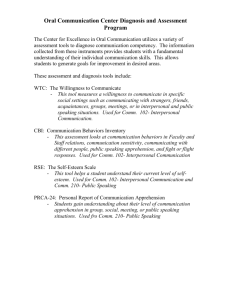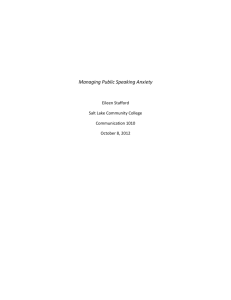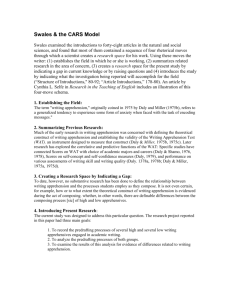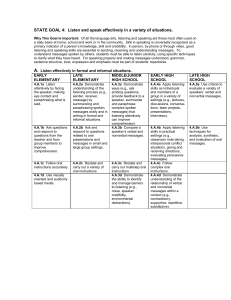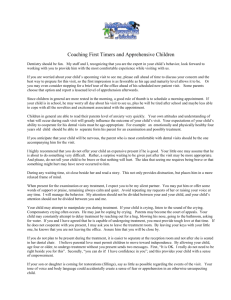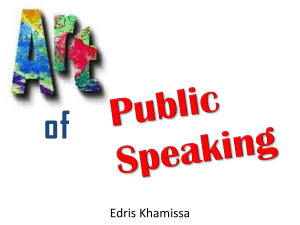THE EFFECTS OF COMMUNICATION APPREHENSION ON
advertisement
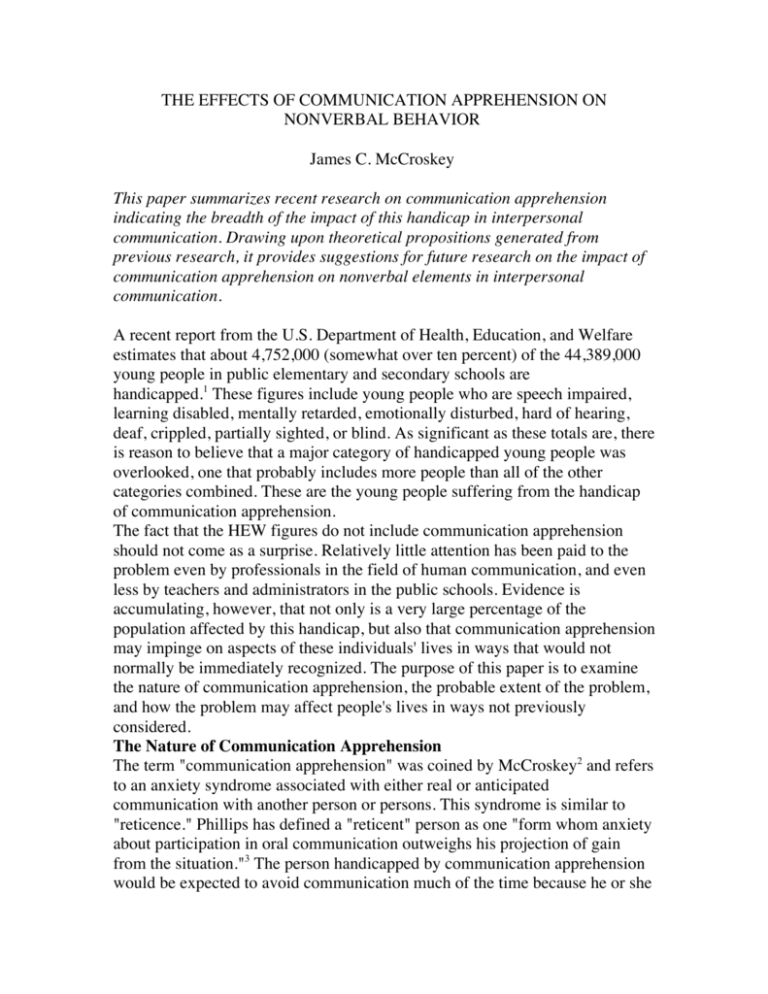
THE EFFECTS OF COMMUNICATION APPREHENSION ON NONVERBAL BEHAVIOR James C. McCroskey This paper summarizes recent research on communication apprehension indicating the breadth of the impact of this handicap in interpersonal communication. Drawing upon theoretical propositions generated from previous research, it provides suggestions for future research on the impact of communication apprehension on nonverbal elements in interpersonal communication. A recent report from the U.S. Department of Health, Education, and Welfare estimates that about 4,752,000 (somewhat over ten percent) of the 44,389,000 young people in public elementary and secondary schools are handicapped.1 These figures include young people who are speech impaired, learning disabled, mentally retarded, emotionally disturbed, hard of hearing, deaf, crippled, partially sighted, or blind. As significant as these totals are, there is reason to believe that a major category of handicapped young people was overlooked, one that probably includes more people than all of the other categories combined. These are the young people suffering from the handicap of communication apprehension. The fact that the HEW figures do not include communication apprehension should not come as a surprise. Relatively little attention has been paid to the problem even by professionals in the field of human communication, and even less by teachers and administrators in the public schools. Evidence is accumulating, however, that not only is a very large percentage of the population affected by this handicap, but also that communication apprehension may impinge on aspects of these individuals' lives in ways that would not normally be immediately recognized. The purpose of this paper is to examine the nature of communication apprehension, the probable extent of the problem, and how the problem may affect people's lives in ways not previously considered. The Nature of Communication Apprehension The term "communication apprehension" was coined by McCroskey2 and refers to an anxiety syndrome associated with either real or anticipated communication with another person or persons. This syndrome is similar to "reticence." Phillips has defined a "reticent" person as one "form whom anxiety about participation in oral communication outweighs his projection of gain from the situation."3 The person handicapped by communication apprehension would be expected to avoid communication much of the time because he or she would experience negative reactions from anxiety that would surpass projected gain from interaction. This, of course, does not mean that the person would never engage in interaction. Rather the person would choose to do so much less frequently than persons not afflicted with communication apprehension under similar circumstances. Since many benefits in our society, from good grades to good jobs, depend heavily on one's ability and willingness to interact with other people, the highly communication-apprehensive person is very likely to fail to share many of the benefits taken for granted by non-apprehensives. Neither the high apprehensive nor the low apprehensive may be aware of this impact. The apprehensive actually may be happy, in that he or she is able to construct an environment in which to live that prevents communication apprehension from intruding. Mr. McCroskey is Professor and Chairman of the Department of Speech Communication at West Virginia University The Effects of Communication Apprehension For many years the field of Speech has been concerned with one manifestation of communication apprehension, state fright in public speaking, and much effort has been directed toward helping people overcome this problem in public speaking courses. Of course, highly apprehensive students usually avoid such courses whenever possible. Further, if they get into one it is usually a very unpleasant, anxiety-provoking experience which accomplishes little at best and may make the situation worse.4 Other manifestations of communication apprehension generally have been ignored. However, it has been established that people suffering from communication apprehension also behave differently in small group communication contexts. Wells and Lashbrook found that high apprehensives interacted less in small groups and, when they interacted, their interactions were less relevant than those of their peers who did not suffer from communication apprehension.5 Studies by Heston6 and Daly7 have also found that high apprehensives interact with less frequency than low apprehensives. Hamilton found that high apprehensives showed more tension, less interest, and talked less in small groups than low apprehensives.8 Sorenson and McCroskey found this same pattern in small group interaction in both zero-history and intact groups.9 Weiner also obtained the same results in a zero-history group.10 Hamilton also found that high apprehensives tended to avoid selfdisclosure more than low apprehensives.11 These behaviors have also been found to have an impact on other group members. Quiggins found that high apprehensives were perceived by other group members to be less extroverted, composed, and task-attractive than low apprehensives. Further, low apprehensive group members saw high apprehensives as less competent and socially attractive than other low apprehensives.12 More recent research has confirmed the negative impact of communication apprehension on interpersonal attraction13 and on perceived credibility.14 It has also been found that high communication apprehensives are less likely to be turned to for opinion leadership than low apprehensives.15 It is clear from these studies that communication apprehension negatively affects the communication behavior of some people in small group interaction. It should not come as a surprise, therefore, to find that communication apprehension is also related to school achievement, as measured by standardized tests, since much instruction in our schools is based on group activity. Bashore found that the degree of communication apprehension in female high school seniors was significantly negatively correlated to the individual's scores on the Illinois State High School test, the verbal score on the Preliminary Scholastic Aptitude Test, and the verbal score on the College Entrance Examination Board Test.16 Extent of the Problem It should be clear from the discussion above that communication apprehension is indeed a handicap that harms some people in our society. The next question concerns how many people are affected by this handicap. Since there has been no widespread testing of young people in the public schools, answering this question must depend on generalization from what sample data is available, most of which is drawn from college populations. On the basis of samples of 1,434 college students at Michigan State University and 2,479 college students at Illinois State University, it has been estimated that between 10 and 20 percent of the population suffer from extreme communication apprehension and possibly as many as 20 percent more suffer from communication apprehension to a degree that it has some impact on their communication behavior.17 Moore has found about the same distribution in a sample of 167 aged citizens.18 Even based on the most conservative figures, we can safely estimate that there are at least as many people suffering from debilitating communication apprehension as suffer from all other handicaps listed in the HEW report cited previously. Communication apprehension, then, may be the single most pervasive handicap confronting children in our schools and citizens in our society. Although methods have been developed and demonstrated to be effective in helping people overcome this handicap, there are only isolated instances where such help is being provided at the present time. Communication Apprehension and Nonverbal Behavior Although research on the effects of communication apprehension is still in its infancy, two recent studies indicate that the impact of this syndrome may be even more pervasive than previously believed. These studies considered two nonverbal behaviors, both remote from one another and not closely associated to previous research. These behaviors were seating choice in a small group and housing choice. These two behaviors were chosen for study previous research has indicated that seating position in a small group19 and housing proximity20 both have an impact on subsequent communication. Research reported by Strodtbeck and Hook21 and Hare and Bales22 indicates that in small group communication settings certain seats are perceived consistently as "leadership" or "dominant" positions. People in these seats tend to be selected as leaders and to interact more frequently than people in other seats. Persons who are highly communication apprehensive would probably find such seats to cause them increased anxiety, since other people might have a high expectation of interaction with them. Weiner hypothesized, therefore, that high apprehensive individuals would tend to choose seats in a small group setting that would not be perceived as "leadership" or "dominant" positions, while low apprehensive individuals would tend to choose the "leadership" or "dominant" positions.23 Weiner's study included 115 college students in a basic communication course. The subjects completed the Personal Report of Communication Apprehension (PRCA-College) developed by McCroskey.24 They also made choices of seats they would prefer in four configurations representing five person groups. Subjects were also asked to "pick the seat that you think the person who wanted to exert the most influence would take" in each configuration. The results indicated that the seats believed to be influential on the basis of the previous research were also chosen as such by these subjects. Subjects one standard deviation above the mean on the PRCA were classified as high communication apprehensives, those one standard deviation below the mean were classified as low communication apprehensives. Frequencies of influential seat choice and non-choice were computed for both groups. The hypothesis was supported in all individual configurations and for all configurations taken together. High communication apprehensives tended to avoid influential seats while low communication apprehensives tended to seek them. This finding, in conjunction with earlier research indicating that people in influential seats tend to have a disproportionate impact on the group product, suggests that communication apprehensives tend to place themselves at a disadvantage in their attempts to avoid communication. While their ideas could be as good as any other group member's, and significant personal benefits could be at stake as well as group benefits, high communication apprehensives will be less likely to have an influence on groups of which they are members than their less apprehensive peers. The choice of where to live is one of the more personal decisions with which an individual is confronted. Although economic circumstances certainly impinge heavily on such decisions, in most instances people have some latitude of choice within their given economic condition. If the impact of communication apprehension is as pervasive as is believed, it might be expected to have an impact on housing choice. McCroskey and Leppard hypothesized that high communication apprehensives will choose housing units where interaction with neighbors is impeded while low communication apprehensives will choose housing units where interaction is facilitated.25 Festinger, Schachter, and Back26 and Blake, Rhead, Wedge and Mouton27 have observed that some housing units, because of their location, tend to facilitate interaction among neighbors, while people in other units tend to have little contact with their neighbors. In order to test their hypothesis, McCroskey and Leppard constructed models of housing areas representing a dormitory, a fraternity/sorority house, a trailer court, and a suburb with private houses. Within each model there were areas similar to those Festinger et al. found to facilitate interaction, areas similar to those in which Festinger et al. found little interaction, and ambiguous areas. Subjects, 115 students in undergraduate communication classes, completed the PRCA and chose the unit from each model that would "enable (them) to feel the most comfortable over an extended period of time."28 High apprehensives were defined as those scoring one standard deviation above the mean on the PRCA, low apprehensives were those scoring one standard deviation below the mean on the PRCA. The hypothesis was supported. The results were significant for all housing types taken together. High apprehensives favored housing in low interaction areas while low apprehensives favored housing in high interaction areas. Although we must take care not to over interpret this type of data, it would appear from these results that communication apprehension does indeed have a far-ranging, pervasive influence on human behavior. Housing has been found in many studies across a wide variety of cultures to have a major impact on the diffusion of innovations in a society.29 One of the best predictors of opinion leadership and the development of local influentials is housing. People in high interaction locations tend to have a major influence on the behavior of other people in their community. The results of the McCroskey and Leppard study, then, suggest that high communication apprehensives are much less likely to have an impact in their community than their less apprehensive neighbors, regardless of the quality of their ideas. Future Research on Communication Apprehension and Nonverbal Communication Behavior The results of the recent studies on seating and housing choices are interesting in and of themselves. The importance of the results, however, is most manifest in the implications we can draw concerning possible additional relationships between communication apprehension and nonverbal communication behaviors. Previous research on communication apprehension has been focused on the relationship between this variable and verbal communication behavior, or, more often, the lack of it. The recent findings indicate that communication apprehension is a pervasive phenomenon that impacts at least some communication-related behaviors that are nonverbal. Clearly, there is a need for additional research exploring the possible relationships between communication apprehension and other nonverbal communication behaviors. Future research should proceed from the theoretical base upon which previous research has been founded, since considerable research has supported this theoretical formulation. Simply stated, these theoretical propositions are as follows: 1. People vary in the degree to which they are apprehensive about communication with other people. 2. People with high communication apprehension seek to avoid communication. 3. People with high communication apprehension engage in less verbal communication than do less apprehensive people. 4. When people with high communication apprehension do communicate, their communication behaviors are different from those people who are less apprehensive. 5. As a result of their communication behavior, high apprehensives are perceived less positively by others than are less apprehensive people. From these propositions we may deduce several testable hypotheses relating to nonverbal communication behavior. Personal Space. People in close proximity are much more likely to interact than people that are more distant from one another. Since high communication apprehensives desire to avoid communication, we may hypothesize that they will establish greater personal space distances both in a normal interaction context and (as indicated in the housing study above) in their general lifestyle patterns. This hypothesis, if confirmed, would suggest an additional hypothesis. That is, high communication apprehensives respond to personal space invasions at a greater distance than do people with less communication apprehension. Eye Contact. The establishment of eye contact generally increases the probability of communication attempts and the continuation of interaction between people. Since high communication apprehensives wish to avoid communication, we may hypothesize that they engage in less direct eye contact and less prolonged eye contact than people with less communication apprehension. Touch. The American culture is generally considered by researchers in the area of nonverbal communication to be a low-touch culture. In addition, touch is often considered to be one of the most intimate forms of interpersonal communication. Since high communication apprehensives wish to avoid communication, we may hypothesize that they are even more averse to being touched than the average person within the culture. Similarly, we may hypothesize that high communication apprehensives are less likely to initiate touching behavior than are people with less communication apprehension. Vocal Behavior. Since people with high communication apprehension have been observed to engage in verbal communication behaviors that are different from behaviors of people who are less apprehensive, we may hypothesize that this difference would also be manifested in the vocal behavior of high communication apprehensives. Specifically, since vocal variety is highly communicative, we may hypothesize that high communication apprehensives will have less vocal variety in their oral communication than will people with less communication apprehension. Kinestic Behavior. Since kinesic behavior is highly communicative and the communication behavior of high communication apprehensives has been found to differ from that of people with less communication apprehension, we may hypothesize that there are two differences in kinesic behavior of high communication apprehensives. First, high communication apprehensives have fewer kinesic movements than people with less communication apprehension. Second, the kinesic behaviors in which high communication apprehensives do engage are more constrained than the kinesic behaviors of people with less communication apprehension. Pause Time. Within each culture there is a normative pattern for the amount of time for pauses in interpersonal interaction. If person A pauses for that normative period, person B is highly likely to initiate the next interaction or response. Since people with high communication apprehension seek to avoid communication and engage in less verbal communication than people with less communication apprehension, we may hypothesize that normative pause time in interpersonal interaction for high communication apprehensives is longer than for people with less communication apprehension. These hypotheses do not exhaust the possible relationships between communication apprehension and nonverbal communication behavior, nor are they intended to. Rather, we propose these hypotheses as suggested directions for future research. These hypothesis might also serve an heuristic function for the generation of additional hypotheses. For example, if any of these hypotheses are subsequently confirmed through research, it would deductively follow that the differences observed should have a differential impact on perceptions of high and low communication apprehensives on the part of other people. Such hypotheses, however, must await results indicating that such differences as those hypothesized above actually exist. The phenomenon of communication apprehension is one that has undoubtedly existed for centuries, but intensive research in this area is still in its first decade. From research which has been reported to date, it is reasonable to speculate that communication apprehension may be the single most significant variable in the interpersonal communication behavior of many people. If this is true, communication apprehension would most certainly have a major impact on nonverbal communication behavior. Future research on the relationship between communication apprehension and nonverbal communication behavior has high promise for producing meaningful results that will contribute to the advancement of human communication theory. NOTES 1 A. Stafford Metz, Number of Pupils with Handicaps in Local Public Schools, Spring 1979, Department of Health, Education and Welfare pub. No. (OE) 73-11107 (Washington, DC: GPO, 1973) p. 2. 2 James C. McCroskey, "Measures of Communication-Bound Anxiety," Speech Monographs, 37 (1970), 269-277. 3 Gerald M. Phillips, "Reticence: Pathology of the Normal Speaker," Speech Monographs, 35 (1968), 40. 4 James C. McCroskey, David C. Ralph, and James E. Barrick, "The Effect of Systematic Desensitization on Speech Anxiety," Speech Teacher, 19 (1970), 32-36. 5 Judith Wells and William B. Lashbrook, "A Study of the Effects of Systematic Desensitization of the Communication Anxiety of Individuals in Small Groups" paper presented to the Speech Communication Association Convention, New Orleans, 1970. 6 Judee K. Heston, "Unwillingness of Communicate and Conflict as Predictors of Information Processing Behaviors," Diss., West Virginia Univ., 1974. 7 John A. Daly, "The Effects of Differential Durations of Time on Interpersonal Judgments Based on Vocal Activity," M.A. Thesis, West Virginia Univ., 1974. 8 Paul R. Hamilton, "The Effect of Risk Proneness on Small Group Interaction, Communication Apprehension, and Self-Disclosure." M.A. Thesis, Illinois State Univ., 1972. 9 Gail A. Sorensen and James C. McCroskey, "The Prediction of Interaction Behavior in Small Groups," paper presented to the Speech communication Association Convention, New York, 1973. 10 Allen N. Weiner, "Machiavellianism as a Predictor of Group Interaction and Cohesion," M.A. Thesis, West Virginia Univ., 1973. 11 Hamilton. 12 James G. Quiggens, "The Effects of High and Low Communication Apprehension on Small Group Member Credibility, Interpersonal Attraction, and Interaction," paper presented to the Speech Communication Association Convention, Chicago, 1972. 13 James C. McCroskey, John A. Daly, Virginia P. Richmond, and Barbara G. Cox, "The Effects of Communication Apprehension on Interpersonal Attraction," Human Communication Research, in press. 14 James C. McCroskey and Virginia P. Richmond, "The Effect of Communication Apprehension on the Perception of Peers," Western Speech Communication Journal, in press. 15 McCroskey and Richmond. See also, H. Thomas Hurt and Katherine Joseph, "The Impact of Communication Apprehension in the Process of Social Change," paper presented to the Eastern Communication Association Convention, New York, 1975. 16 David N. Bashore, "Relationships Among Speech Anxiety, IQ, and High School Achievement," M.A. Thesis, Illinois State Univ., 1971. 17 James C. McCroskey, "The Implementation of a Large-Scale Program of Systematic Desensitization for Communication Apprehension," Speech Teacher, 21, (1972), 255-264. 18 Dennis L. Moore, "The Effects of Systematic Desensitization on Communication Apprehension in an Aged Population," M.A. Thesis, Illinois State Univ., 1972. 19 A. Paul Hare and Robert F. Bales, "Seating Position and Small Group Interaction," Sociometry, 26 (1963), 480-486. 20 Leon Festinger, Stanley Schachter, and Kurt Back, Social Pressures in Informal Groups: A Study of Human Factors in Housing (New York: Harper & Row, 1950). 21 Fred L. Strodtbeck and L. Haramon Hook, "The Social Dimensions of a Twelve-Man Jury Table," Sociometry, 24 (1961), 397-415. 22 Hare and Bales. 23 Weiner. 24 McCroskey, "Measures of Communication-Bound Anxiety." 25 James C. McCroskey and Thomas Leppard, "The Effects of Communication Apprehension on Nonverbal Behavior," paper presented to the Eastern Communication Association Convention, New York, 1975. 26 Festinger, Schachter, and Back. 27 Robert R. Blake, Clifton c. Rhead, Bryant Wedge, and Jane Srygley Mouton, "Housing Architecture and Social Interaction," Sociometry, 19, (1966), 133139. 28 McCroskey and Leppard, p. 4. 29 Everett M. Rogers and Floyd F. Shoemaker, Communication of Innovations (New York: the Free Press, 1971). Click Here To Go Back To PERIODICALS
